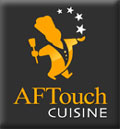Commercial Stocks

Now, just a quick word about commercial powdered stocks, bouillon paste and other meat extracts. The father of these mass-produced meat extracts was Justus Von Liebig famous inventor of the theory that searing meat seals in the juices, which is, now, proved to be false. Anyway, back to the powdered stuff, these meats extracts are made by simmering meat scraps and bones in water. Then this stock is clarified and reduced to about 10% of its initial volume. The finished extract is a viscous mixture made of 20% water; 50% amino-acids, peptides, gelatin and other related molecules; 5% salt and 20% minerals. Most of these products are less concentrated and are supplemented with various artificial flavours.
Has these mass-produced meat extracts are mainly meat based they need to be improved by briefly cooking them with some vegetables, wine and herbs before using them as part of a sauce.
Has these mass-produced meat extracts are mainly meat based they need to be improved by briefly cooking them with some vegetables, wine and herbs before using them as part of a sauce.
German analytical chemist who collaborated with Wöhler in organic chemistry investigations. They discovered the benzoyl radical (C7H5O) in the 1830s, providing seeming support for Berzelius's radical theory. He measured the composition of silver fulminate to be 77.53% silver oxide and 22.47% cyanic acid, which was the same ratio as Wohler had found for cyanic acid. At first, Liebig thought Wohler was wrong, but he was eventually forced to agree that the compounds had the same chemical formula.
Liebig promoted chemistry as the central science, trying to underscore its direct benefit to mankind in the form of pharmaceuticals. He developed a technique for determining the carbon and hydrogen contained in a sample from the carbon dioxide and water given off when a compound was burned. He also attempted to derive physiological phenomena from physical and chemical laws.
In Agricultural Chemistry (1842), he presented organic chemistry in its application to physiology and pathology. Another of Liebig's major accomplishments was in the field of applied chemistry. Two books, Organic Chemistry an its Application to Agriculture and Physiology, and Organic Chemistry in its Application to Physiology and Pathology, published in 1840 and 1842 respectively, revolutionized food production. Even though some of Liebig's ideas were later proved to be incorrect, he set in motion an application of chemical principles that had a profound effect on the future welfare of mankind. For the first time it was possible to produce enough food stuffs to feed the growing population.
He was influenced by Helmholtz in attempting to demonstrate that body heat and muscular action could be derived from the oxidation of foodstuffs. He also sought to establish an elemental balance between ingesta, excreta, and respiratory gases.
1 comments:
Subscribe to:
Post Comments (Atom)









